Abstract
Elevated activity of the eukaryotic translation initiation factor 4E (eIF4E) plays crucial roles in tumorigenesis and disease progression by disproportionately increasing translation of mRNAs coding proteins that play significant roles in all aspects of malignancy, providing that eIF4E as an attractive target for therapeutic intervention. In this study, we showed that inhibition of eIF4E by small interfering RNAs (siRNA) resulted in cell cycle arrest and suppression of colony formation in MDA-MB-231 triple-negative (TN) breast cancer cells. Migration transwell assay revealed that repression of eIF4E effectively inhibited motility of MDA-MB-231 cancer cells. Importantly, we showed that silencing of eIF4E sensitized MDA-MB-231 cells to chemotherapeutic drugs of cisplatin, adriamycin, paclitaxel and docetaxel as assessed by MTT assay. Moreover, Western blot assay showed that eIF4E siRNA increased Bax/Bcl-2 ratio in MDA-MB-231 cells. Taken together, we showed that knockdown of eIF4E suppressed cell growth and migration, enhanced chemosensitivity, suggesting a potential therapeutic target in TN breast carcinoma.




Similar content being viewed by others
Abbreviations
- eIF4E:
-
The eukaryotic translation initiation factor 4E
- TN:
-
Triple-negative
- ER:
-
Estrogen receptor
- PgR:
-
Progesterone receptor
- PI3K:
-
Phosphatidylinositol 3-kinase
- ODC:
-
Ornithine decarboxylase
- MMP-9:
-
Matrix metalloproteinase-9
- siRNA:
-
Small interfering RNAs
- ADR:
-
Adriamycin
References
Hortobagyi GN, et al. The global breast cancer burden: variations in epidemiology and survival. Clin Breast Cancer. 2005;6:391–401.
Perou CM, et al. Molecular portraits of human breast tumours. Nature. 2000;406:747–52.
Harris L, et al. American society of clinical oncology 2007 update of recommendations for the use of tumor markers in breast cancer. J Clin Oncol. 2007;25:5287–312.
Boccardo F, Rubagotti A. Switching to aromatase inhibitors in early breast cancer. Lancet. 2007;369:533–5.
Smith I, et al. 2-year follow-up of trastuzumab after adjuvant chemotherapy in HER2-positive breast cancer: a randomised controlled trial. Lancet. 2007;369:29–36.
Romond EH, et al. Trastuzumab plus adjuvant chemotherapy for operable HER2-positive breast cancer. N Engl J Med. 2005;353:1673–84.
Joensuu H, et al. Adjuvant docetaxel or vinorelbine with or without trastuzumab for breast cancer. N Engl J Med. 2006;354:809–20.
Schneider BP, et al. Triple-negative breast cancer: risk factors to potential targets. Clin Cancer Res. 2008;14:8010–8.
Kurebayashi J. Possible treatment strategies for triple-negative breast cancer on the basis of molecular characteristics. Breast Cancer. 2009;16:275–80.
von der Haar T, Gross JD, Wagner G, McCarthy JE. The mRNA cap-binding protein eIF4E in post-transcriptional gene expression. Nat Struct Mol Biol. 2004;11:503–11.
Pestova TV, Hellen CU. The structure and function of initiation factors in eukaryotic protein synthesis. Cell Mol Life Sci. 2000;57:651–74.
De Benedetti A, Graff JR. eIF-4E expression and its role in malignancies and metastases. Oncogene. 2004;23:3189–99.
Flowers A, et al. Eukaryotic initiation factor 4E overexpression in triple-negative breast cancer predicts a worse outcome. Surgery. 2009;146:220–6.
Rosenwald IB, et al. Eukaryotic translation initiation factor 4E regulates expression of cyclin D1 at transcriptional and post-transcriptional levels. J Biol Chem. 1995;270:21176–80.
Li S, et al. Translation factor eIF4E rescues cells from Myc-dependent apoptosis by inhibiting cytochrome c release. J Biol Chem. 2003;278:3015–22.
Graff JR, Konicek BW, Carter JH, Marcusson EG. Targeting the eukaryotic translation initiation factor 4E for cancer therapy. Cancer Res. 2008;68:631–4.
Wendel HG, et al. Survival signalling by Akt and eIF4E in oncogenesis and cancer therapy. Nature. 2004;428:332–7.
Kentsis A, Topisirovic I, Culjkovic B, Shao L, Borden KL. Ribavirin suppresses eIF4E-mediated oncogenic transformation by physical mimicry of the 7-methyl guanosine mRNA cap. Proc Natl Acad Sci USA. 2004;101:18105–10.
Moerke NJ, et al. Small-molecule inhibition of the interaction between the translation initiation factors eIF4E and eIF4G. Cell. 2007;128:257–67.
Graff JR, et al. Therapeutic suppression of translation initiation factor eIF4E expression reduces tumor growth without toxicity. J Clin Invest. 2007;117:2638–48.
Oridate N, Kim HJ, Xu X, Lotan R. Growth inhibition of head and neck squamous carcinoma cells by small interfering RNAs targeting eIF4E or cyclin D1 alone or combined with cisplatin. Cancer Biol Ther. 2005;4:318–23.
Hennessy BT, Smith DL, Ram PT, Lu Y, Mills GB. Exploiting the PI3K/AKT pathway for cancer drug discovery. Nat Rev Drug Discov. 2005;4:988–1004.
West KA, Castillo SS, Dennis PA. Activation of the PI3K/Akt pathway and chemotherapeutic resistance. Drug Resist Updat. 2002;5:234–48.
Li BD, Liu L, Dawson M, De Benedetti A. Overexpression of eukaryotic initiation factor 4E (eIF4E) in breast carcinoma. Cancer. 1997;79:2385–90.
Li BD, McDonald JC, Nassar R, De Benedetti A. Clinical outcome in stage I to III breast carcinoma and eIF4E overexpression. Ann Surg. 1998;227:756–756l; discussion 761–753.
Byrnes K, et al. High eIF4E, VEGF, and microvessel density in stage I to III breast cancer. Ann Surg. 2006;243:684–90; discussion 691–682.
Nathan CO, et al. Elevated expression of eIF4E and FGF-2 isoforms during vascularization of breast carcinomas. Oncogene. 1997;15:1087–94.
Culjkovic B, Borden KL. Understanding and targeting the eukaryotic translation initiation factor eIF4E in head and neck cancer. J Oncol. 2009;2009:981679.
Soni A, et al. eIF4E knockdown decreases breast cancer cell growth without activating Akt signaling. Mol Cancer Ther. 2008;7:1782–8.
Arslan C, Dizdar O, Altundag K. Pharmacotherapy of triple-negative breast cancer. Expert Opin Pharmacother. 2009;10:2081–93.
Dong K, et al. Tumor-specific RNAi targeting eIF4E suppresses tumor growth, induces apoptosis and enhances cisplatin cytotoxicity in human breast carcinoma cells. Breast Cancer Res Treat. 2009;113:443–56.
Acknowledgments
This research work was supported by Guangdong Province Science & technology Fund (2008B06060029 to LP X) and Major Science and Technology Project of “National significant new drug creation” (2008ZX09312-002 to LP X).
Author information
Authors and Affiliations
Corresponding author
Additional information
Fei-fei Zhou and Min Yan contributed equally to this work.
Rights and permissions
About this article
Cite this article
Zhou, Ff., Yan, M., Guo, Gf. et al. Knockdown of eIF4E suppresses cell growth and migration, enhances chemosensitivity and correlates with increase in Bax/Bcl-2 ratio in triple-negative breast cancer cells. Med Oncol 28, 1302–1307 (2011). https://doi.org/10.1007/s12032-010-9630-0
Received:
Accepted:
Published:
Issue Date:
DOI: https://doi.org/10.1007/s12032-010-9630-0




